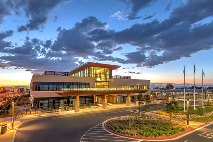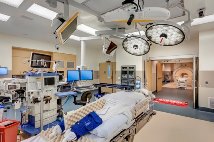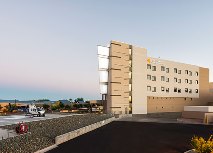Over the months leading to our annual Design-Build Conference & Expo, hosted this year in Denver Colorado from November 2-4, we have been posting weekly projects that have earned the distinction as a 2015 DBIA Merit Award winner. These projects, at a minimum, resulted in highly successful delivery and achieved best value while meeting design and construction quality, cost and schedule goals. These projects will also be highlighted during the Design-Build Conference & Expo on November 3 during an Awards Reception. Please join us by registering for the conference here. This week we recognize the winners from our Healthcare Facilities Category.
Chandler Regional Medical Center
The client turned to design-build to streamline delivery and reduce the risk of their capital improvement projects. As a result, the design-build team conducted constructability reviews of design documents, which enabled the team to formally identify high-risk areas of potential conflict to resolve prior to construction. The design-build model was especially conducive to working around and on top of an active, functioning hospital. It is inherently a cohesive, integrated process that incorporates multiple stakeholder requirements. Rooted in collaboration and dedicated to honoring Dignity Health’s Mission, Vision and Values, a collective commitment was made by the architect, contractor and owner to involve all stakeholders from Leadership through the end users during the design and construction phases. This cooperative environment was best exhibited as the owner came up against challenges securing additional capital and was forced to ask the design-build team to “slow down, but continue to proceed.” According to a testimonial from the owner, “Even with a handicap like that, [the team] still finished ahead of schedule.”
Summary:
Organized by departmental service lines and overseen by a core group of corporate and facility leaders, the design-build team sought to create solutions to expand the hospital’s services to serve the growing needs of the Chandler, Arizona, community. A total of nearly 180,000 square feet were added to the existing facility and major program components were added. The additions included a new Level I Trauma Emergency Department consisting of 11 triage positions, 4 trauma rooms, 31 treatment rooms, and 15 fast track rooms which support approximately 85,000 annual patient visits, 6 additional operating rooms (OR), new pre/post-operative procedure units which support a total of 16 ORs and other procedure rooms, new patient unit floors, and 64 medical/surgical patient rooms (32 beds per floor). While the goal was to complete the project as quickly as possible so the hospital could start generating revenue, the design-build approach allowed the project to be completed nearly four months ahead of schedule.
 High Desert Regional Health Center
High Desert Regional Health Center
Challenge Design-Build Project Delivery Addressed:
Frequent funding losses, cost overruns and leadership changes drove the use of design-build to streamline the process and efficiently complete the project on budget. For example, a delay in the county’s execution of the contract required the team to strategize different alternatives to its accelerated schedule. The team developed a multi-phased bid package approach that allowed for a head start on the site and structural packages. Getting a head start on several components allowed the team to expedite the start of construction while the design was still being finalized. And when late owner design changes added decorative elements and redesigns, the duration of the construction schedule was not impacted because the team’s trade partners were active team members throughout the project.
Summary:
The people of the High Desert in Lancaster, California, have long relied on Los Angeles County Healthcare facilities to meet their healthcare needs. Until now, the only location for those services was set in the middle of a sprawling correctional facility community on the outskirts of town and through a network of clinics sprawled throughout the region. For this project, added value was about much more than just dollars, it was about the value this project provided to the Lancaster community and the High Desert region. Recent healthcare reform not only changed the focus away from hospitalization to a model driven more by outpatient care, but also changed the nature of reimbursements and created health insurance exchanges. These changes now provided patients a choice in providers, thus creating a need for the County to compete for patients with other healthcare organizations. Using design-build, County Supervisors hoped to capitalize on the creative strength and construction expertise of a team to deliver a new cutting-edge facility that would provide better service, but also meet the higher expectations of the patient population. The County selected a new location in the heart of the city to emphasize their commitment to the region with a state-of-the-art medical care facility.
 St. Jude Medical Center Northwest Tower
St. Jude Medical Center Northwest Tower
Challenge Design-Build Project Delivery Addressed:
The owner chose design-build delivery to lower the overall design and construction cost and to bring a heightened level of accountability to the design phase. As the Southeast Tower’s original program drivers shifted and the location was challenged with site constraints, constructability issues and cost escalation, the design-build team, working with St. Joseph Health, developed a solution that would do more than deliver a new tower ahead of schedule and under initial budget and target cost. The improved solution included revisiting the site location with a program adjusted to consider the changing dynamics in healthcare delivery and reimbursement and that reduced the original schedule and budget.
Summary:
The St. Jude Medical Center Northwest Tower project in Fullerton, California, is a model for best practices in team collaboration and project delivery, setting new standards for St. Joseph Health — the 10th largest not-for-profit health system in the United States — and all project stakeholders. Guided by the core values of passion, teamwork, integrity and innovation, the project team’s efforts will have a lasting impact on how challenges are solved and future projects are delivered within the health system and beyond. An integral part of the multi-phased master plan at the medical center, the project included construction of a 200,000-square-foot, four-story acute care building and a 14,000-square-foot central utility plant. A bridge was also constructed at the new tower’s fourth floor connecting it to the existing hospital. Prior to construction of the tower, McCarthy performed seven months of major utility work and demolished an existing medical records building and parking garage. Along with International Parking Design as the architect, new surface parking and street improvements were also conducted, adding 215 parking spaces to an existing 455-car parking structure.

